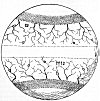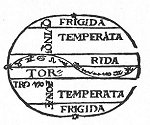
Sacred Texts Earth Mysteries Index Previous Next

"BECAUSE IT PLEASETH more and makes a greater impression upon us," wrote the old English Platonist Thomas Burnet, "to see things represented to the Eye, than to read their description in words, we have ventured to give a model of the Primæval Earth, with its Zones or greater Climates, and the general order and tracts of its Rivers. Not that we believe things to have been in the very same form as here exhibited, but this may serve as a general Idea of that Earth, which may be wrought into more exactness, according as we are able to enlarge or correct our thoughts hereafter . . . . The Rivers of that Earth, you see, were in most respects different, and in some respects contrary to ours, and if you could turn our Rivers backwards, to run from the Sea towards their Fountain-heads, they would more resemble the course of these Antediluvian Rivers; for they were greatest at their first setting out; and the Current thereafter, when it was more weak, and the Chanel more shallow, was divided into many branches, and little Rivers, like the Arteries in our Body, that carry the Blood, they are greatest at first, and the further they go from the Heart, their Source, the less they grow and divide into a multitude of little
branches, which lose themselves insensibly in the habit of the flesh as these little Floods did in the Sands of the

Click to enlarge
FIGURE 34. The Primæval Earth, with its Zones or greater Climates, and the general order and tracts of its Rivers.
(From The Theory of the Earth; Thomas Burnet, 1697.)
[paragraph continues] Earthe." This is a very curious conception of the counter-course of "primæval" rivers; it is exactly as if we conceived of the Missouri-Mississippi system, for instance, as rising in the Gulf of Mexico and flowing north until it
begins to divide and subdivide into dozens of lesser streams, all of which finally dwindle away into the Earth instead of rising from it.
What was the state of the primæval Earth before man appeared, and with him, trouble? All the Creation stories

FIGURE 34A. Zones or Climates of the Earth, with the Zodiac.
(From Sphæra emendata; Joannes Sacro Bosco, Cologne, 1601.)
give a common answer--harmony; harmony of all the spheres. It is in the song to Mahat, with its ordered account of the separation of the five great Elements from Chaos, and their recombinings into the bodies of the universe. "He made them all to move evenly," says the Creation legend of the Lenape, after the Great Manito had formed land and sky and moon and stars; and in the pictograph the even movement is a spiral line. In Sebastien Muenster's Cosmographia Universalis (1559), at the beginning of the chapter on "The creation and disposing of the primordial Earth and Sea," is an old drawing evidently intended to show the paradisaical state of terrestrial affairs at the end of the Fifth Day of Creation, with the
great stage built and the great scene set and lighted for the entrance of man and the beginning of his drama (Plate VI). It is a picture in successive planes of the Genesis story, with a charming addition--the boat with sails, floating in the foreground; and, on it, a little three-storied house--the Ark, perhaps, whose part in the coming drama had been already foreseen by the Creator, and which was to become, of all the vanished treasures of a drowned and broken Earth, man's single precious possession.